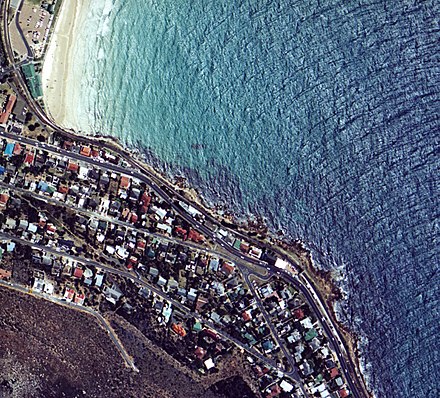Diving the Cape Peninsula and False Bay/Sunny Cove - shoreline dive site at Fish Hoek on the Cape Peninsula east coast
The dive site Sunny Cove is a rocky shoreline reef in the Fish Hoek area on the False Bay coast of the Cape Peninsula, near Cape Town in the Western Cape province of South Africa.
Understand
 See also: Diving the Cape Peninsula and False Bay#Understand
See also: Diving the Cape Peninsula and False Bay#Understand
The access is relatively easy and the site is fairly sheltered from south west swell.
Position
- Sunny Cove reef 📍: S34°08.68’ E018°26.30’ — Just east of the pedestrian bridge at Sunny Cove railway station.
This site is in the Table Mountain National Park Marine Protected Area since 2004. A permit is required.

Name
Named after the "Sunny Cove" railway station at the site, which was probably named after the general location, though it is not clear what cove is referred to.
Depth
Maximum depth is approximately 11 m over the sand.
Topography
 Moderate relief sandstone rocks, ridges and gullies shelving down to sand at about 10 m.
Moderate relief sandstone rocks, ridges and gullies shelving down to sand at about 10 m.
Geology: Ordivician sandstone of the Table Mountain group. Probably Peninsula formation, or the underlying Graafwater formation. Strike is north-west/south east, and the dip is shallow (about 7°)and to the south west.
Conditions
Often at its best during or after westerly winds. The site is fairly well sheltered from south west swell. Usually considered a winter dive site, but also may be dived in summer if the south-easter has not blown for a few days.
Facilities
None. The public toilets at the railway siding have been locked up and are not accessible.
Get in
 This dive is generally dived from the shore, though the site appears to be less frequently dived than in the past. There is parking at the side of the main road near the station. Walk over the pedestrian bridge and to the south east about 50 m to a grassy patch at the side of the path.
Entry area is at the north side of the low rocky promontory visible in the middle of the aerial photo. This is also usually suitable for exit, but occasionally the inlet at the south of the promontory may be more suitable or convenient. The water is quite shallow in these areas, and there is kelp which both moderates the surge and gets in the way.
This dive is generally dived from the shore, though the site appears to be less frequently dived than in the past. There is parking at the side of the main road near the station. Walk over the pedestrian bridge and to the south east about 50 m to a grassy patch at the side of the path.
Entry area is at the north side of the low rocky promontory visible in the middle of the aerial photo. This is also usually suitable for exit, but occasionally the inlet at the south of the promontory may be more suitable or convenient. The water is quite shallow in these areas, and there is kelp which both moderates the surge and gets in the way.
See
Marine life
Not particularly colourful, but quite a variety of invertebrate and seaweed species. Great white sharks have been seen from the shore cruising past the site.
Photography
Close-up photography is most appropriate at this site.
Suggested Routes
No particular routes recommended. It is often worth spending some time over the sand, but most of the dive would normally be on the inshore reefs.
Stay safe
See also: Diving the Cape Peninsula and False Bay#Stay safe
Hazards
Sea urchins. A swimmer was taken by a great white shark near this site in 2004.
Skills
No special skills are required. The site is suitable for snorkelling and has been used for training entry level divers.
Moderate fitness and agility are required for the shore access.
Equipment
See also: Diving the Cape Peninsula and False Bay#Equipment
No special equipment required. A compass can be useful if you swim out over the sand.
Nearby
- Kalk Bay Harbour Wall 📍
- Fish Hoek Reef 📍
- Quarry 📍
- Quarry Barge 📍
- Glencairn Fan Garden 📍
- P87 📍
- SS Clan Stuart 📍
Back to the list of Alphabetical list of sites, or dive sites in the Fish Hoek and Glencairn area
Other regional dive sites:
Sunny Cove
Timezone:MultipleCoordinates:-34.14, 18.44